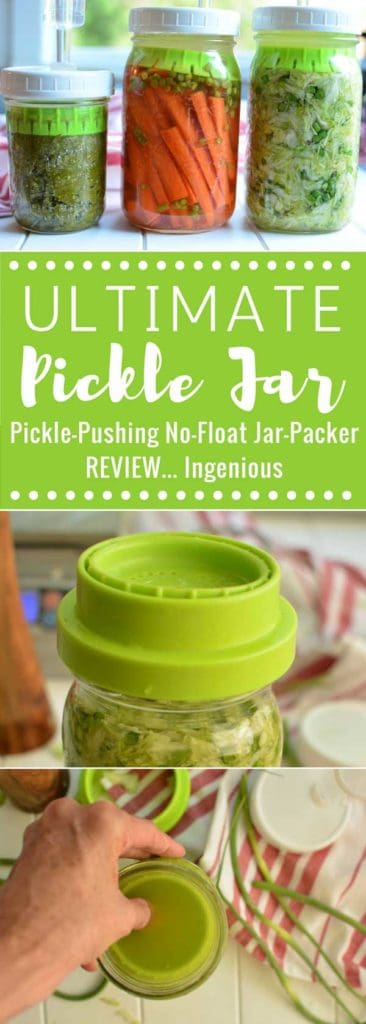A Pickle-Pushing No-Float Jar-Packer!
A What?
I’ll get to that, but first…
THE Fermentation Challenge
Fermentation of sauerkraut and other vegetables is an anaerobic process. You’ll hear this refrain from me time and time again as I help you along your fermentation journey.
What does this mean?
The beneficial bacteria, the bacteria you want furiously multiplying inside that jar of yours don’t do their best work in a jar full of air. They need the jar to be anaerobic, or without air.
In contrast…
The bad bacteria and the yeasts and molds that you don’t want in you jar, thrive on air.
Use the right amount of salt and keep out the air and your chances for success, your ability to ferment mold-free, no-yeast sauerkraut, skyrocket.
So, the challenge is to keep the air out of your jar and your ferment below the brine.
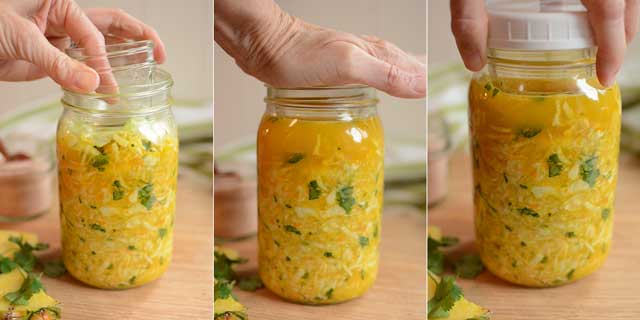
With my SureFire Sauerkraut in a Jar Method, you pack everything into a jar, place a “weight,” or small jelly jar on top and screw on the lid.
The jelly jar acts as a counter-force in the jar. As the sauerkraut pushes up on the little jar, it’s held in place by the lid and can go no further, thus remaining below the brine.
The lid – loosely screwed on – prevents air from entering the jar, yet allows the escape of CO2.
The main drawback of the small jelly jar is that it takes up space that is needed for the brine. Consequently, brine often overflows during the fermentation process. But, I like that my weight is made of glass, a material I feel comfortable using in an acidic environment.
The main drawback of the white plastic lid is that it is not 100% air tight, which allows CO2 to escape, needed to prevent a build up of gases, but also allows a small amount of air to enter the jar.
So, I’m always looking for ways to build a better mousetrap for fermentation in quart (liter) canning jars.
Mike, owner of The Ultimate Pickle Jar recently sent me – as a gift – his product:
The Pickle-Pushing No-Float Jar-Packer. (Affiliate Link)
Review of the Pickle-Pushing No-Float Jar-Packer
Review of: Pickle-Pushing No-Float Jar-Packer (Affiliate Link) by The Ultimate Pick Jar (Non-Affiliate Link)
Use: With quart (liter) jars. Holds your ferment below the brine and keeps air out.
Evaluation is with similar products in mind. Upcoming posts will cover Pickle Pebbles with Pickle Pipes, the FermentEm Waterless Airlock, SteriLIDS and the Kraut Source Fermentation Lid.
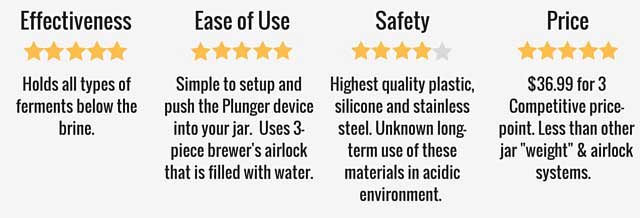
Product Information
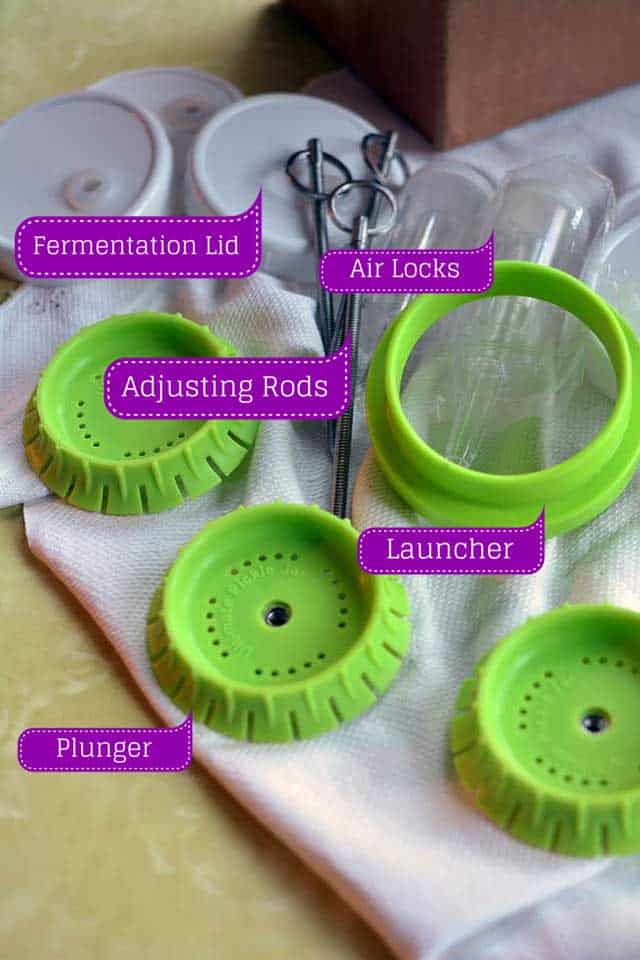
All components are made from acid and brine resistant materials. Shown are the components for a 3-jar set. A set-up for one quart (liter) mason jar includes a:
- Plunger.
The work horse. This is what gets pushed down onto your ferment and is held securely in place below the neck of your jar by fins that push against the sides of the jar. It’s a round disk with small holes in it, fins around the edge and a center hole with a threaded metal insert.
Made from FDA food-grade, BPA-free and phthalate-free silicone. - Adjusting Rod.
This is screwed down through the center of the plunger and prevents the Plunger from tilting sideways when fermenting loose vegetables in brine.
Made from 316 Stainless Steel. - Launcher.
The fins of the Plunger are held “closed” by the Launcher while the Plunger is pushed down into your jar. Quite easy to do.
Made from BPA-free and phthalate-free plastic. - Plastic Fermentation Lid.
Comes with a silicone gasket and drilled hole encased in a silicone grommet for insertion of airlock.
BPA-free and phthalate-free plastic. - 3-Piece Plastic Airlock.
Inserted into the center of your fermentation lid and filled with water to form an anaerobic fermentation environment. - Plastic Storage Lid.
Comes with a silicone gasket for storage of your ferment.
The Pickle-Pushing No-Float Jar-Packer in Action
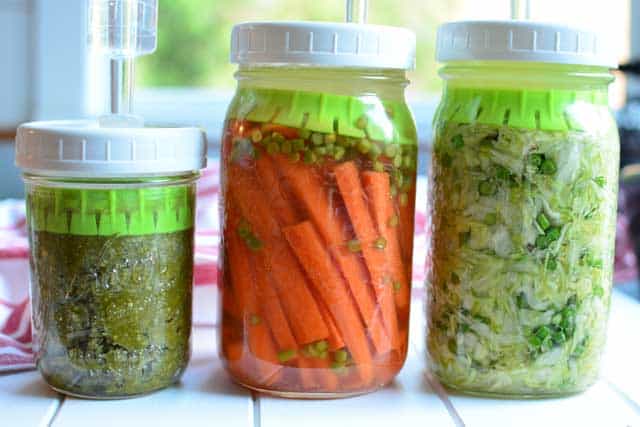 I tested the Pickle-Pushing No-Float Jar-Packer with three types of ferments: paste, loose vegetables fermented in brine and standard sauerkraut. All were flavored with garlic scapes just harvested from my garden.
I tested the Pickle-Pushing No-Float Jar-Packer with three types of ferments: paste, loose vegetables fermented in brine and standard sauerkraut. All were flavored with garlic scapes just harvested from my garden.
Garlic Scape Sauerkraut
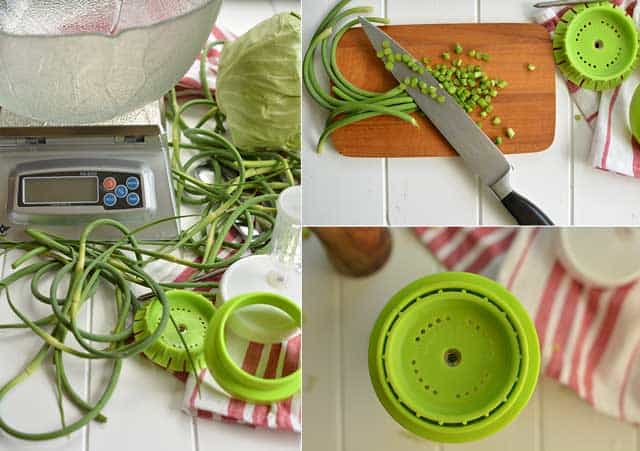 Bowl on the scale and ready to weigh the finely sliced garlic scapes.
Bowl on the scale and ready to weigh the finely sliced garlic scapes.
The Plunger, with its fins, next to the sliced garlic scapes. Then, the Plunger has been inserted into the Launcher and is sitting on top of the jar ready to be pushed down on top of the sauerkraut mixture.
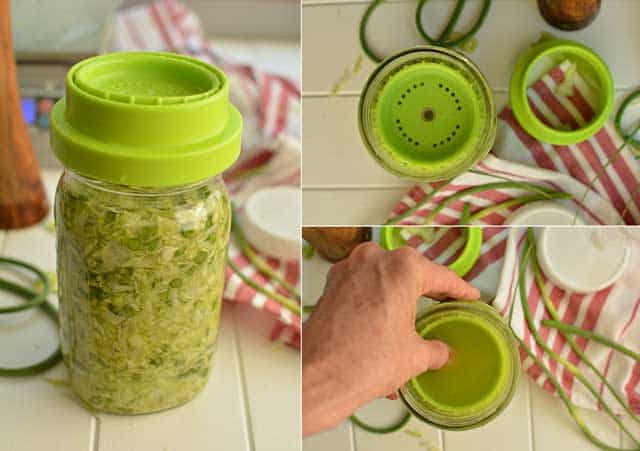 The Launcher and Plunger assembly ready for “deployment.” The Plunger in the jar and then pressed down and below the brine.
The Launcher and Plunger assembly ready for “deployment.” The Plunger in the jar and then pressed down and below the brine.
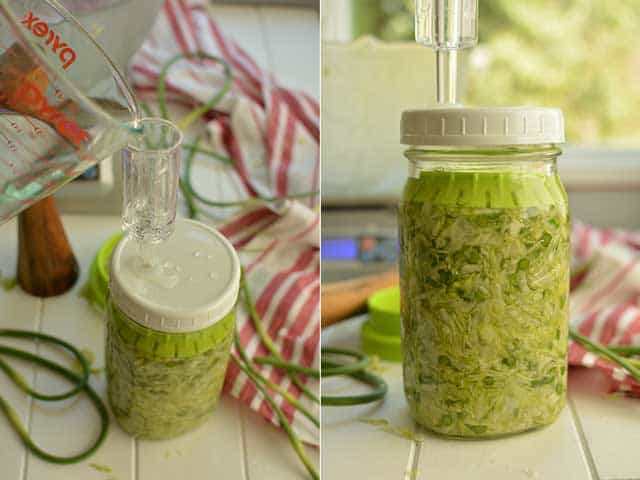 Airlock is filled with water for an anaerobic fermentation environment. Below the brine and happily fermenting.
Airlock is filled with water for an anaerobic fermentation environment. Below the brine and happily fermenting.
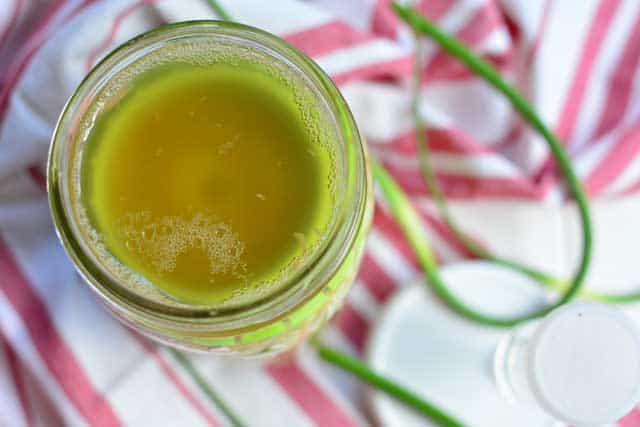
Checked one week later. NO brine overflow during the active first phase. Plenty of brine covering the Plunger. And, when checked at the end of the second week all was still covered with plenty of brine. I’m a happy camper.
My Discoveries: I love the fact that there was no brine overflow as often happens when I’m using the jelly jar as a weight. The actual Plunger that sits down in the jar of fermenting sauerkraut takes up very little space.
You’ll notice that I did not use the Adjusting Rod. I saw no need for it with sauerkraut. If you pack your jar to the neck then the Plunger stays in place right at the neck and this is the spot at which it works best.
Fermented Garlic Scape Carrot Sticks
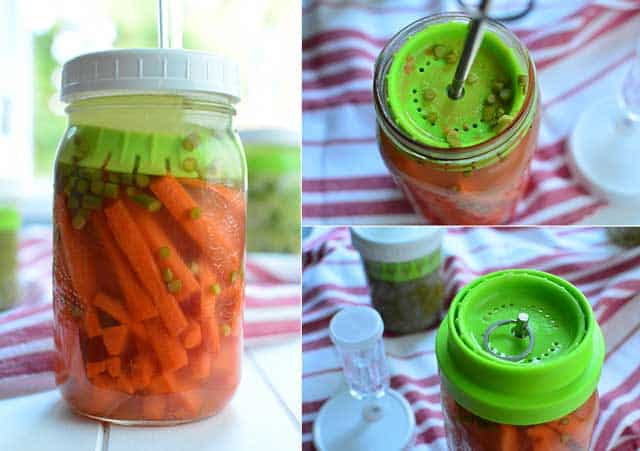 Here we are a few days into the fermentation process and the Plunger has tilted such that garlic scape bits are floating to the surface. It would help if I had followed directions!
Here we are a few days into the fermentation process and the Plunger has tilted such that garlic scape bits are floating to the surface. It would help if I had followed directions!
So, I used the Adjusting Rod to remove the Plunger and clean things up.
Then using the Launcher, I reinserted the Plunger complete with the necessary Adjusting Rod and what a difference that made.
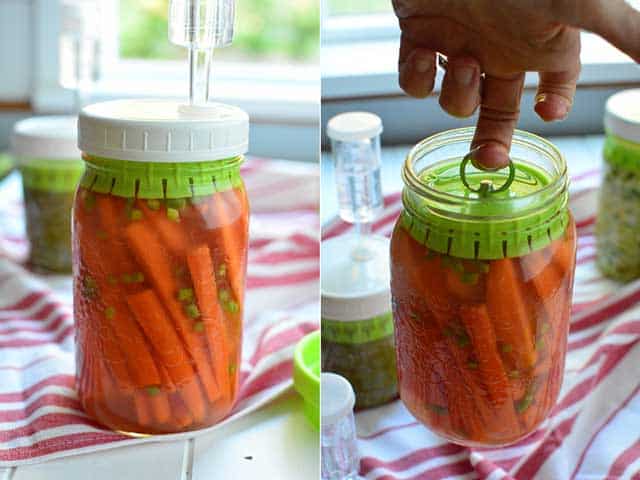 The Plunger is held in place. No garlic scapes will be able to float to the surface.
The Plunger is held in place. No garlic scapes will be able to float to the surface.
And by holding the jar by the ring of the Adjusting Rod, it is clear that the Plunger won’t be going anywhere either. Any forces from the build up of CO2 gasses will not be able to push it up and out of the brine.
My Discoveries: Loose vegetables in a brine ferment are always a challenge to keep below the brine. The Plunger – with Adjusting Rod – holds everything below the brine with ease. I tend to ferment brined vegetables for short time periods because of the air exposure that happens to the bits that float to the surface. I will now feel much more comfortable fermenting them for a longer time period.
Garlic Scape Paste
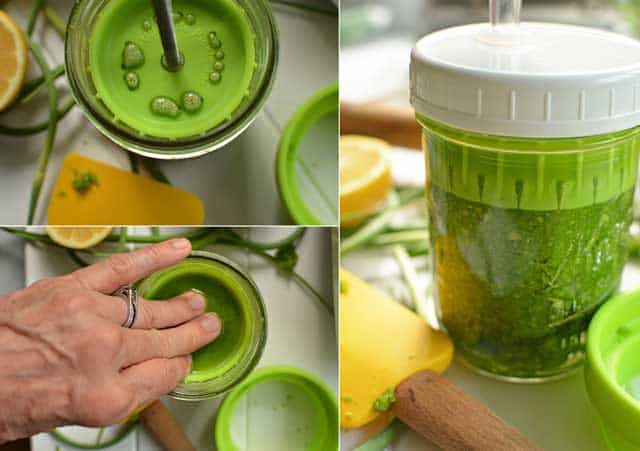 The jar of garlic scape paste packed and the Plunger pushed down into place. Extra encouragement with my hand forces a nice bit of brine to rise to the surface. Air-lock lid in place and ready to ferment.
The jar of garlic scape paste packed and the Plunger pushed down into place. Extra encouragement with my hand forces a nice bit of brine to rise to the surface. Air-lock lid in place and ready to ferment.
My Discoveries: A little jar can work as a weight but it takes up a lot of real estate when fermenting in smaller jars, which I tend to use for pastes and relishes. The supplied Adjusting Rod is too long for the smaller jar I used – a shorter one is planned – but the tabs held the Plunger securely in place. There was no movement of the Plunger during the fermentation process and brine always covered the paste. Keeping brine above pastes and relishes is a bit of a challenge because most weights don’t exert enough pressure.
Conclusion
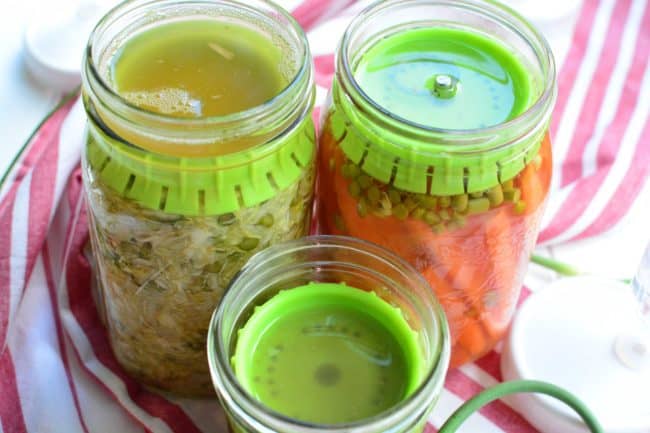 Here is a peek at my ferments, a week into the fermentation process. Below the brine and all is fine. Time to put back on my airlock lids and let the wonderful microbial world work for me.
Here is a peek at my ferments, a week into the fermentation process. Below the brine and all is fine. Time to put back on my airlock lids and let the wonderful microbial world work for me.
There are other ways to hold your ferment below the brine, some more cost effective than others.
In this post, I share the pros and cons of one product, the Pickle-Pushing No-Float Jar-Packer on the market and will do so also with Pickle Pebbles & Pipes, the FermentEm Waterless Airlock, SteriLIDS and the Kraut Source Fermentation Lid.
Pros of the Pickle-Pushing No-Float Jar-Packer
- Complete fermentation setup with Plunger – that acts much better than a weight – and exerts over 4 pounds of force to compact jar contents and keep under brine.
- Plunger takes up very little space in your jar, therefore no loss of brine.
- System prevents bits floating to the surface, thus preventing mold growth.
- Works to hold a variety of types of ferments below the brine: sauerkraut, loose vegetables and pastes and relishes.
- Comes with photo-rich set of instructions, along with instructional videos available on product website.
Cons of the Pickle-Pushing No-Float Jar-Packer
- Lots of parts to keep track of when not in use.
- Tall profile of the 3-piece airlock can be a bit awkward on some counter spaces.
- Plunger – that sits in your ferment – is made from silicone. Though top-quality and BPA-free and phthalate-free, we just don’t know the long-term impact of these materials in an acidic environment.
- For the Plunger to work effectively, the jar needs to be packed to the right level (right to the neck of the jar).
I’m happy to have the Pickle-Pushing No-Float Jar-Packer (Affiliate link) in my fermentation repertoire and will use it often. It truly is a ingenious solution to keeping everything below the brine without using a weight.
If you have used this product – or if you do – feel free to leave comments or share your thoughts.
As I use my set throughout the sauerkraut making season, I will update you with any new discoveries.

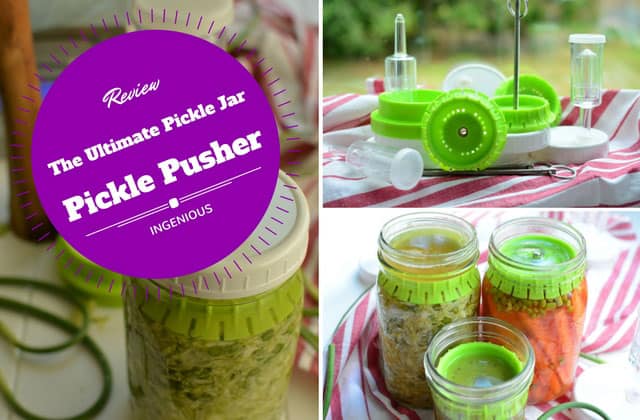

 This post may contain affiliate links which won’t change your price but will share some commission.
This post may contain affiliate links which won’t change your price but will share some commission.